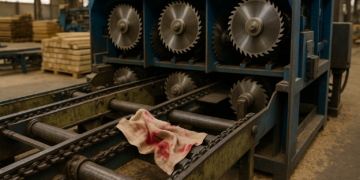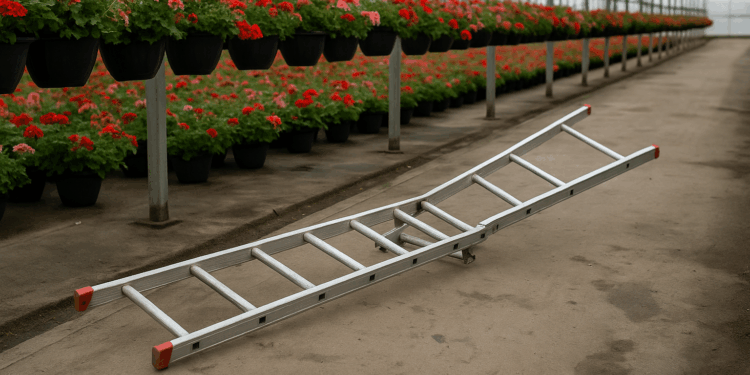Story Highlight
– Horticultural company fined for employee’s ladder fall.
– Employee suffered serious injuries, including five broken ribs.
– Investigation revealed failure to ensure safe work conditions.
– Company pleaded guilty, fined £80,000 and £7,061 costs.
– HSE emphasizes risks of working at height remain significant.
Full Story
A horticultural business based in Banbury has been penalised following an incident in which an employee sustained severe injuries from a ladder fall. The event occurred on 7 June 2023, when the employee was assigned to inspect an irrigation system watering plants in hanging baskets at their facility.
As he ascended the ladder, it unexpectedly toppled over, leading to significant injuries including five fractured ribs and a partially collapsed lung. An inquiry conducted by the Health and Safety Executive (HSE) revealed that Ball Colegrave Ltd. neglected to ensure the health, safety, and well-being of its workers as far as reasonably practicable. The investigation specifically identified a lack of adequate planning and safety measures for tasks carried out at height, which are known to present considerable risks.
Falls from heights are consistently among the predominant causes of workplace injuries and fatalities, prompting the HSE to issue comprehensive guidelines to promote safety in such operations.
Ball Colegrave Limited, situated on Milton Road in West Adderbury, entered a plea of guilty to breaching section 2(1) of the Health and Safety at Work etc Act 1974. In a ruling delivered at Oxford Magistrates’ Court on 14 October 2025, the company was fined £80,000 and ordered to cover costs amounting to £7,061.
In the aftermath of the court proceedings, HSE inspector Rebecca Gibson commented on the incident, emphasising the imperative for employers to take effective measures to mitigate risks associated with working at height. She stated, “This incident highlights the duty on employers to ensure that should do all they can to minimise the risk from working at height.”
Gibson added that without proper planning and the right tools for the job, employees may fall victim to critical injuries, reiterating, “Falls from height remain a leading cause of workplace injury and death.”
Supporting the prosecution was HSE enforcement lawyer Arafq Nabi, alongside paralegal officer Gabrielle O’Sullivan, both of whom contributed to bringing the case to court.
The HSE acts as the national authority in the UK for maintaining health and safety regulations within workplaces. Their mission is dedicated to safeguarding individuals and environments, assisting in achieving the highest standards of safety and health.
For further inquiries or details regarding the involved legislation, the HSE provides additional information on their website, allowing access to their latest news releases and updates regarding health and safety regulations.
The outcomes of this case serve as a significant reminder to all employers of the critical importance of adhering to health and safety legislation, particularly in relation to working at height. It is imperative that businesses review their safety practices, ensuring all employees are equipped with proper training and suitable equipment to conduct work safely.
In light of this incident, there may be increased scrutiny on the horticultural sector during workplace safety inspections. The repercussions of disregarding safety protocols can lead not only to physical harm but also to substantial financial penalties, as demonstrated in this case. The severe injuries suffered by the employee underscore the need for enhanced safety measures and responsibility among employers to protect their workforce.
It remains essential for organisations to cultivate a safety-first culture, encouraging staff to report hazards and engage in ongoing training to prevent similar occurrences in the future. By prioritising health and safety, companies not only comply with legal requirements but also foster a more productive and secure working environment for their employees.























This case is a clear example of why working at height must never be treated as an afterthought. Planning, risk assessment and appropriate control measures are essential before anyone climbs a ladder. Employers should consider whether the task can be done from the ground or with safer equipment such as towers or mobile platforms, ensure suitable ladders are used only where they are appropriate, and make sure workers are trained, supervised and fit for the task. Regular inspection and maintenance of equipment and a culture that empowers staff to stop unsafe work would help prevent incidents like this.
This case is a clear reminder that work at height demands proper planning and control. Employers must ensure tasks are risk assessed, suitable equipment is provided and inspected, and staff are trained and supervised to use safer alternatives to ladders where possible. Failing to put simple precautions in place can lead to serious injury and significant penalties.
This case is a clear reminder that work at height is inherently hazardous and requires proper planning, risk assessment, and control measures. Employers must ensure safe systems for inspecting and maintaining equipment, provide suitable access equipment and training, and supervise tasks to prevent falls. The fine reflects the serious consequences of failing to manage these risks. Organizations should review their procedures, learn from this incident and take immediate steps to protect workers before someone else is injured.
This is a stark reminder that working at height requires proper planning and control every time. Ladders are inherently unstable and should only be used for low risk, short duration tasks with appropriate assessment, supervision and rescue arrangements. Employers must ensure suitable equipment such as access platforms where needed, provide training and clear safe systems of work, and carry out effective risk assessments and inspections. The cost of inadequate controls is measured in human suffering and avoidable fines.